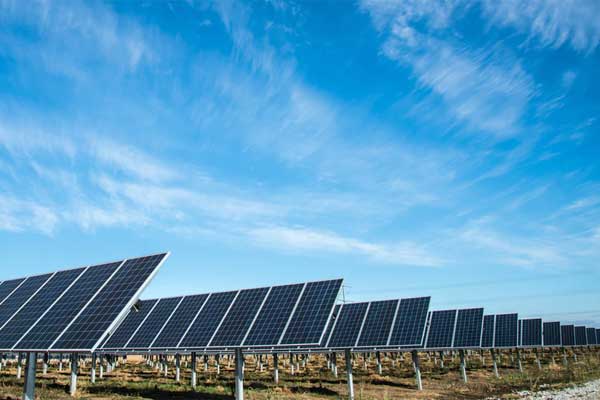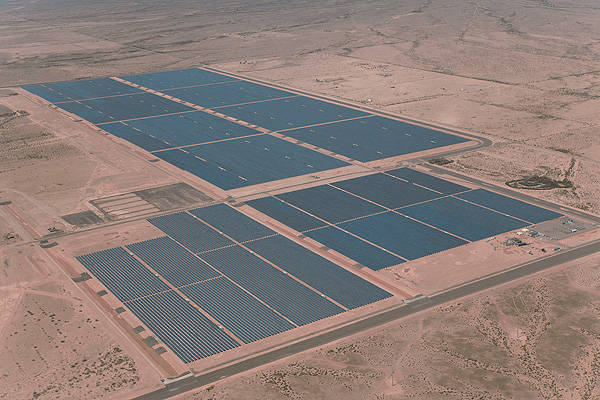Washington DC — An analysis conducted by the SUN DAY Campaign of data released over the past decade by the U.S. Energy Information Administration (EIA) and the Federal Energy Regulatory Commission (FERC) as well as near-term forecasts by both agencies suggest continued strong growth by renewable energy sources.
However, unless accelerated, that growth will fall short of President Biden’s clean power goals for 2030.
EIA’s data from the past ten years indicate renewables could be one-third of U.S. electrical generation in 2030.
EIA’s most recent “Electric Power Monthly” report reveals that renewable energy sources (i.e., biomass, geothermal, hydropower, solar, wind) provided 22.5% of U.S. electrical generation during the first four months of 2021. [1] A decade earlier, during the first four months of 2011, renewables provided 13.75% of electrical production. Thus, over the intervening years, renewables added – on average – a bit less than one percent annually to their share of the nation’s electricity supply.
Almost all the growth can be attributed to wind and solar which expanded from 3.3% in April 2011 (year-to-date) to 13.9% in April 2021 (YTD). Meanwhile, the share of electrical generation attributable to biomass, geothermal, and hydropower combined has remained virtually unchanged, accounting for between a bit less than 9% and a bit more than 10% each year.
Should that trend continue, renewables would be on track to provide approximately one-third of U.S. electrical generation in 2030 with wind and solar combined providing about 23% and the combination of biomass, geothermal, and hydropower contributing another 10%.
For the immediate future, this trend appears to be confirmed by EIA in its most recent monthly “Short-Term Energy Outlook” (STEO) which forecasts utility-scale renewables to grow from 19.8% in 2020 to 20.6% in 2021 and then to 22.5% in 2022. If small-scale solar were to be included, renewables were 20.6% of U.S. electrical generation in 2020 and are on track to exceed 21% in 2021 and 23% in 2022.[2]
FERC’s data over the last decade further confirm likelihood of one-third renewables by 2030.
The growth rates suggested by EIA’s data seem to be confirmed by a ten-year look-back at FERC’s monthly “Energy Infrastructure Update” reports which track the installed electrical capacity of all generating sources. For April 2021, FERC reports that renewable sources accounted for 24.77% of installed, utility-scale (i.e., greater than 1-MW) generating capacity in the U.S. A decade earlier – i.e., in April 2011, renewables’ share of generating capacity was 13.97%.
Thus, as is true for actual electrical generation, renewables are increasing their share of generating capacity by about one percent per year with almost all the growth attributable to solar and wind. In April 2011, solar and wind accounted for 3.74% of the nation’s generating capacity while hydropower, biomass, and geothermal accounted for 10.23%. By April 2021, solar and wind had grown to 14.96% while the other renewables accounted for 9.81%.
Also, in each “Energy Infrastructure Update,” FERC provides data for “high probability additions” and “retirements” during the upcoming three years for each energy source. Its latest 3-year data foresee the net capacity for coal, oil, natural gas, and nuclear power combined dropping by more than 14 gigawatts (GW) whereas renewables – mostly solar and wind – are forecast to grow by over 64 GW. Should that transpire, renewables’ share of domestic generating capacity would rise to 28.83% by April 2023 (i.e., adding about 1.35% to its share each year).
If that projected growth rate is sustained for the balance of the current decade, renewables’ share of the nation’s generating capacity would be approximately 38% by 2030. With 38% of installed capacity, renewables might be expected to provide 32-35% of actual generation — a figure consistent with what can be extrapolated from EIA’s data.[3]
However, there are hints in EIA’s and FERC’s data that renewables’ share of electrical generation in 2030 could be larger – perhaps reaching 50%.
A review of EIA’s end-of-year data reveals strong annual growth rates for wind and solar during each of the last six years (it is difficult to evaluate earlier years because of changes in EIA’s reporting methodology). On average, electrical generation by wind has grown by just over 10% per year since the end of 2014. During that same period, solar averaged an annual growth rate of over 30%, although that has slowed during the past three years to 21% per year.
If one assumes sustained future wind and solar growth rates of 10% and 20% per year respectively, wind generation in 2030 would be more than double that reported for 2020 while solar generation would grow by six-fold. These figures are more than consistent with (in fact, conservative compared to) EIA’s latest STEO forecasts which project wind-generated electricity to grow by 26.5% between 2020 and 2022 while utility-scale solar-generated electricity is forecast to expand by 63.5% over the next two years.
Should this growth scenario materialize, then by 2030 solar and wind would each be generating about the same amount of electricity. If total U.S. electrical generation by all sources remains about the same as in 2020, wind and solar could each be accounting for about 20% of the nation’s electrical generation in 2030. Adding in the 10% likely to be provided by biomass, geothermal, and hydropower combined, renewables could be providing half of the nation’s electricity within a decade.
FERC’s near-term forecasts reinforce the plausibility of this scenario – at least for solar. Over the next three years, FERC anticipates the “high probability” addition of 42.8 GW of utility-scale solar to the 57.9 GW of existing solar capacity – an increase of 74%. “High probability” wind additions would expand wind’s current capacity of 125.7 GW by another 20.5 GW. However, beyond the “high probability additions,” FERC also reports that there may be as much as 58.2 GW more wind capacity and 121.1 GW more solar capacity in the pipeline.
Further, with virtually every new monthly issue of its “Energy Infrastructure Update,” FERC scales up its three-year forecast for new solar. In its first such forecast published in February 2019, FERC projected the addition of 12-GW of solar by March 2022. In its most recent “Update,” FERC’s three-year forecast had nearly quadrupled to almost 43-GW of new solar capacity by May 2024.
EIA and FERC data also indicate reaching 80% renewables by 2030 remains possible … but a challenge.
Reaching 50% renewables by the end of this decade would still remain well short of President Biden’s call for 80% clean power by 2030 (assuming “clean” means “renewable” and does not include nuclear power or fossil fuels with carbon capture).
However, EIA’s historic data also suggest a faster growth track is possible for wind and solar which comes close to Biden’s target. Three times during the past six years (2016, 2017, 2020), the annual growth rate for wind-generated electricity has increased by 12.0% or more. And, as earlier noted, while averaging only 21.1% during the last three years, the average annual growth rate for solar between December 2014 and December 2020 actually surpassed 30% (i.e., 31.1%).
If these higher growth rates (i.e., wind – 12% and solar – 30%) were replicated and sustained each year for the balance of the decade – an admittedly very challenging goal – wind could account for about 25% of U.S. electrical generation by 2030 while solar would be nearly 45%. Add in another 10% from hydropower, biomass, and geothermal and one reaches Biden’s 80% target. [4]
A national clean electricity standard could make such a scenario – or comparable alternatives -realistic. Yet, even without a national clean electricity standard to drive growth, other factors could still enable renewables to secure a substantially larger share of electrical generating capacity and provide more actual generation than historical trends suggest.
These additional factors include, but are not limited to:
**The cost of solar and wind as well as storage continues to drop, albeit at a possibly slower rate than before.
**The increasing likelihood of multiple large-scale offshore wind farms in the coming decade could substantially boost wind’s generating share (e.g., the Biden Administration’s target of 60-GW of offshore wind would increase current U.S. wind capacity by 50%).
**States, as well as a growing number of counties and cities, are strengthening their renewable portfolio standards as many utilities announce ever-more aggressive renewable energy procurements.
**Corporate purchases of renewable energy are expanding rapidly as is the number of commercial businesses, schools, other institutions, and private homeowners opting to install solar.
**Opportunities do exist for at least modest growth by biomass, geothermal, and hydropower.
**The environmental threat of worsening climate change seems likely accelerate the transition to lower-emission energy sources.
# # # # # # # # #
REPORTS CITED:
The latest issue of EIA’s “Electric Power Monthly” (with data through April 2021) was issued on June 24, 2021. To view it, see Table ES1.B. For all earlier issues, follow the link to “Previous Issues” and again see Table ES1.B in each report.
The latest issue of EIA’s “Short-Term Energy Outlook” was issued on July 7, 2021. View it. For EIA’s near-term renewable energy projections, see Table 8b “U.S. Renewable Electricity Generation and Capacity.”
The latest issue of FERC’s “Energy Infrastructure Update” (with data through May 2021) was issued on July 12, 2021. To view it, Earlier issues may be found here and following the link to “Energy Infrastructure.” See the tables titled “New Generation In-Service,” “Total Available Installed Generating Capacity,” and “Generation Capacity Additions and Retirements”.
NOTES:
[1] Unless otherwise indicated, electricity figures attributed to EIA include its “estimated small-scale solar photovoltaic” (e.g., rooftop solar systems). However, FERC’s solar capacity figures only include “utility-scale” systems 1-MW or larger.
[2] The STEO projections do not include distributed (e.g., rooftop) solar which accounts for almost a third (30.7%) of total solar output and just a bit under five percent (4.9%) of total net U.S. electrical generation by renewable energy sources.
[3] Actual electrical generation by renewable sources is likely to be several percentage points less than their installed capacity because most renewable sources have lower capacity factors than do most fossil fuels and nuclear power. Thus, at the end of 2020, utility-scale renewables accounted for 24.1% of installed capacity but only 19.8% of actual generation.
[4] These numbers pre-suppose that total annual U.S. electrical generation remains essentially stable at about 4,100 TWh (Terawatthours or 4,100,000 thousand Megawatt-hours) – a level slightly higher than that reported by EIA for 2020. It is conceivable, though, that a growing economy, expanding population, and increased electrification of the buildings and transportation sectors could increase electrical demand and production unless offset by efficiency improvements. In that case, electrical generation by renewables would need to increase as well.
# # # # # # # # #
The SUN DAY Campaign is a non-profit research and educational organization founded in 1992 to aggressively promote 100% reliance on sustainable energy technologies as cost-effective alternatives to nuclear power and fossil fuels and as a strategy for addressing climate change.















Comments